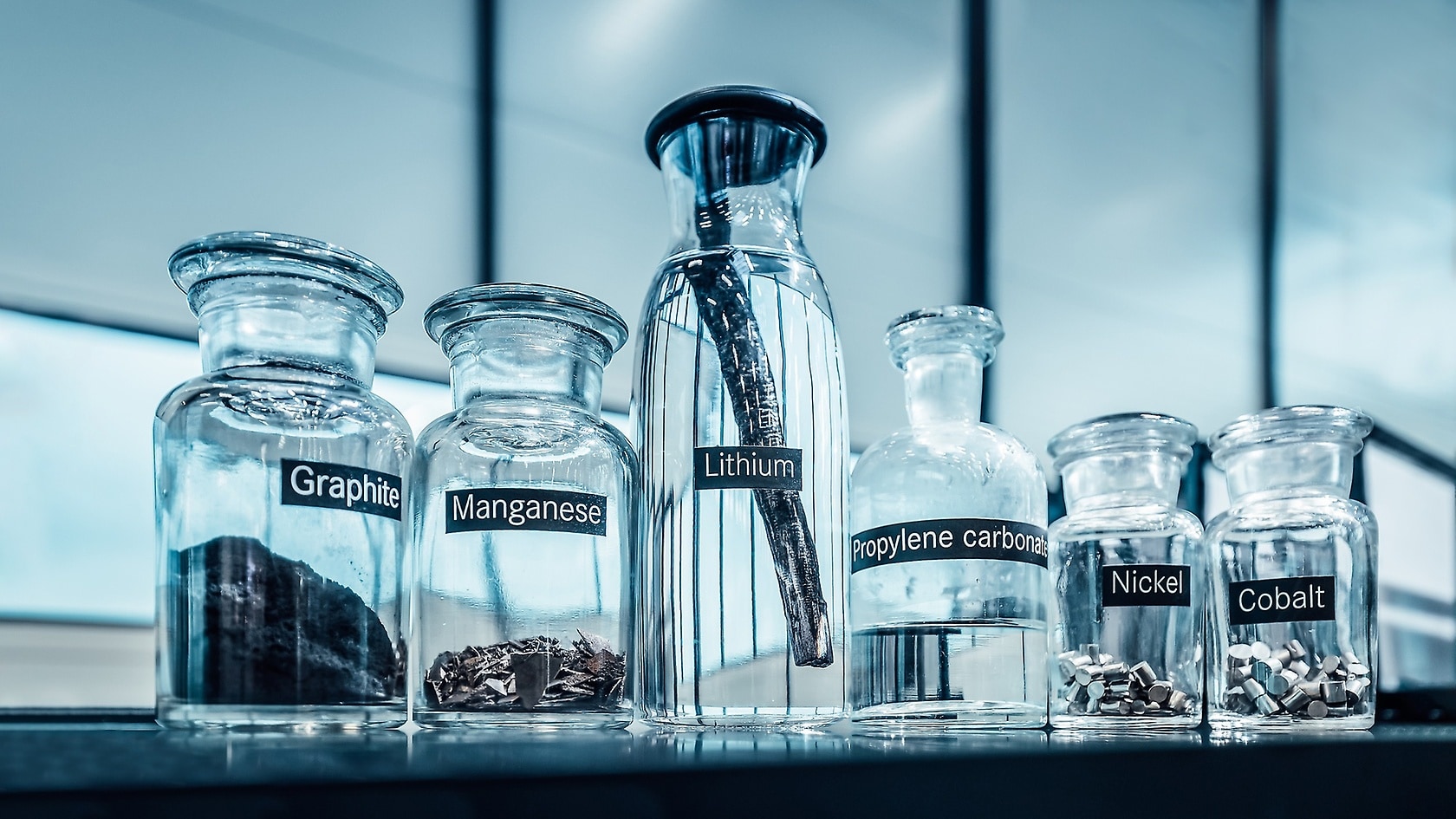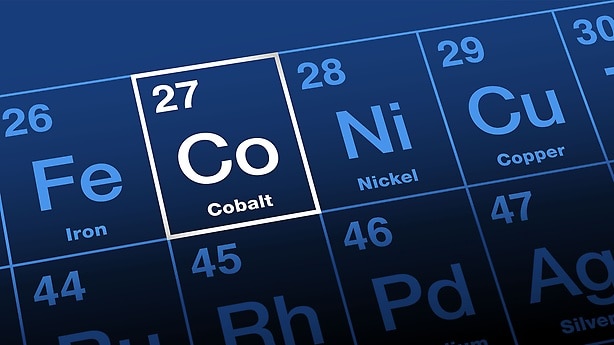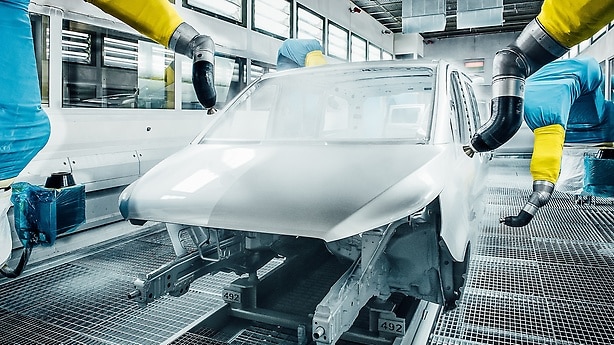Mercedes-Benz Group pursues a risk-based approach. This means that we aim to create as much transparency as possible in our raw material supply chains that carry a risk for human rights violations. In this way, we identify areas that are critical to human rights and define and implement targeted counter-measures.
In order to produce vehicles, we need certain raw materials that can, in some circumstances, be mined or processed under conditions that are critical to human rights. That is why the supervision of these supply chains has a high priority for us. Under the umbrella of the Human Rights Respect System (HRRS), we analyze 24 critical raw materials for human rights risks, create transparency in our supply chains and take measures to reduce risks. We publish the results of the analyses and the resulting measures in our raw materials report. Learn more about our goals in the sustainability report.
Our commitment regarding battery raw materials
Battery-electric drive systems are a key element on the way to making our fleet of new vehicles net carbon-neutral over the vehicles' entire life cycle by 2039. This is associated with a changing and increasing demand for specific raw materials, in particular cobalt and lithium, but also nickel, graphite, manganese, and copper. These raw materials for batteries are among the 24 raw materials, which we have identified as being potentially critical in terms of human rights in their use, extraction or further processing. In order to counter possible environmental and human rights risks we carry out comprehensive reviews of these raw materials in the form of raw materials assessments. The results of the raw material assessments on the raw materials aluminium, cobalt, lithium, mica, tin and tungsten are presented in our current raw material report.
In addition to an initial review of the situation, important elements of our assessments include the intensive analysis of our supply chains and the involvement of our direct suppliers and further stakeholders from science, industry, and civil society.
Our raw materials assessments consist of three steps:
- We create transparency along the respective raw material supply chains.
- We identify risk hot spots in these supply chains.
- We define and implement risk mitigating measures and make sure that they are effective.
By the end of 2025, we plan to review 70 percent of all high-risk raw materials. By 2028, we intend to define appropriate measures for 100 percent of our raw materials that pose an increased risk of human rights violations.
The raw materials assessments of the battery raw materials named above have all at least started in the year 2021.
We identify and prioritise risks in our raw material supply chains in line with the United Nations (UN)
We use different criteria for the analysis like the number of processing steps within our supply chains as well as the technical methods of raw material extraction and the origin of raw materials. Another criterion is the future relevance of a raw material for our products with regard to the transition to electric mobility. Because raw material and service supply chains are very different we look at them separately.
| Risk Areas | Definition |
|---|---|
| Working Conditions incl. Occupational Health and Safety | Working conditions with (potential) negative effects on the physical and mental health of workers. |
| Child Labour | Illegal or exploitative employment of children (potentially) depriving children of their childhood and education. |
| Modern Slavery incl. Forced Labour | (Potential) exploitation of workers who cannot refuse or leave due to violence or threats. |
| Community and Indigenous Rights | (Potentially) adverse impacts on the rights and livelihoods of affected local and indigenous communities. |
| Excessive Violence by Public and Private Security Forces | (Potential) human rights abuses committed by private and public security forces to which a company can become complicit. |
| Environmental Risks with Impact on Human Rights | Adverse impacts on the environment, which (potentially) affect the enjoyment of human rights. |
| Business Conduct in Conflict and High Risk Areas | (Potentially) adverse impacts of a company's operation, contributing to conflict, which result from a company's own activities or its relationships with third parties including suppliers. |
| Serious Human Rights Abuses | Serious human rights violations with which a company's supply chain can (potentially) be confronted. |
| Supplier DDMS | Inadequate due diligence processes in companies along the supply chain. |
In 2024, the existing risk areas were expanded to include five additional environmental risk fields. These are in line with the OECD Handbook for Environmental Due Diligence and the EU Battery Regulation. The assessment of the 24 critical raw materials is carried out step by step, starting with the battery raw materials lithium, cobalt, nickel, and graphite.
| Risk Areas | Definition |
|---|---|
| Biodiversity | (Potential) Loss of biodiversity and degradation of lands (or ecosystems) also in form of deforestation. |
| Water | (Potential) adverse impact on water and water availability in form of pollution or high consumption. |
| Air | (Potential) adverse impact on air in form of pollution and emissions and further effects on other environmental mediums. (Potential) adverse impact by GHG emissions from processes, related by energy use as well as the acceleration of climate change as a consequence and its adverse impacts. |
| Soil | (Potential) adverse impact on soil in form of pollution and degradation including erosion. |
| Waste, hazardous substances, and plant safety | (Potential) adverse impact caused by improper use or disposal of hazardous materials or waste mismanagement and physical instability of facilities. |
A detailed list of the general risks of relevant raw materials as well as a supply chain-specific analysis is currently under development and will be published in the Mercedes-Benz Raw Materials Report on our website.
Evaluation of the risk fields
For the assessment of risk fields, we put the logic of the UN Guiding Principles on Business and Human Rights into practice and analyse the extent of a risk ("scale") as well as the number of people affected ("scope").
For this purpose, we take into account relevant reports, studies, expert interviews as well as collaborative work. One example is the Raw Materials Outlook
With the assessment, we identify and prioritise the most salient risks and adjust our measures accordingly. We reflect on the result of our assessment and the risk reduction measures with external stakeholders who have special expertise in the individual raw materials as well as with potentially affected persons and their representatives.
With the assessment, we identify and prioritise the risks with the highest relevance and adjust our measures accordingly. The risks are assessed based on a four-level scale from 0 = minor to 3 = critical Risk.
| Risk Rating | not applicable | 0 Minor | 1 Moderate | 2 Major | 3 Critical |
|---|---|---|---|---|---|
| Scale: How serious is the negative impact on those affected? | not applicable | Other human rights impacted than bodily / mental harm | May / May not result in bodily / mental harm through other human rights impacted | Serious bodily / mental harm | Loss of life |
| Scope: How many people are affected? | not applicable | Under 100 rightsholders impacted | Between 100 and 500 rightsholders impacted | Between 500 and 1000 rightsholders impacted | More than 1000 rightsholders impacted |
¹ OECD Due Diligence Guidance to Promote Responsible Supply Chains for Minerals from Conflict and High-Risk Areas.
Industrial mining is always linked with interventions in the environment and thus also with potential effects on the living conditions of the local population. The risks identified in the context of previous raw materials assessments include, for example:
- risks to the health of employees and the local population around the mine sites, e.g. through emissions of dust due to the large-scale transfer of materials and transport operations,
- effects on the surrounding agriculture due to changes in or pollution of groundwater and open water,
- effects on the way of life of the local population, including indigenous communities, in individual cases including resettlement, e.g. due to the land requirements of large mines.
In addition to our own raw material assessments, from which we derive material-specific measures, the use of recognized external standards is a central instrument in order to meet our own due diligence responsibilities. The Standard for Responsible Mining of the Initiative for Responsible Mining Assurance (IRMA)
Since 2021, we have specified the IRMA standard as a precondition for all battery-related contracts, and we require our suppliers to use cobalt, lithium, nickel, graphite, manganese, and copper exclusively from IRMA-audited mines in newly awarded projects. Because the industry-wide application of the IRMA standard is still in its early stages, we are making use of transition periods. With our clear requirement, we accelerate the establishment of the standard in the market under realistic conditions: We are gradually moving towards increasingly responsible practices, with the medium-term objective of a robust certification. We thus expect the supplier to provide at least proof of “IRMA Transparency
This article was last updated in June 2024.







